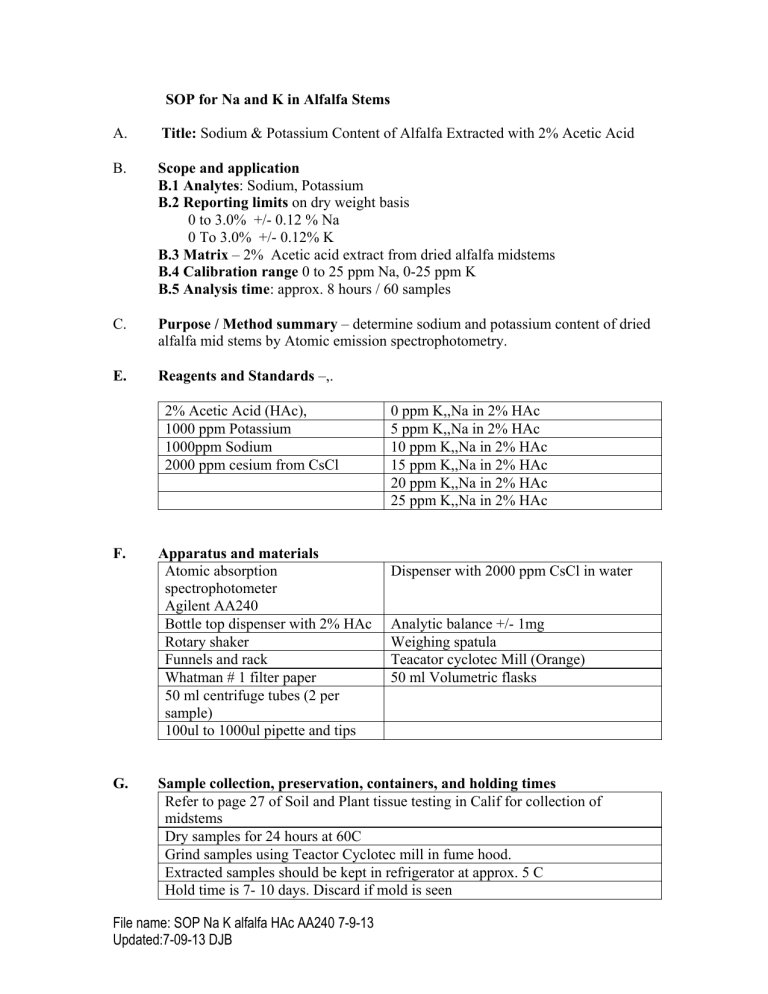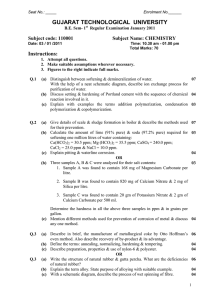SOP for Na and K in Alfalfa Stems Title: B.

SOP for Na and K in Alfalfa Stems
A. Title: Sodium & Potassium Content of Alfalfa Extracted with 2% Acetic Acid
B. Scope and application
B.1 Analytes : Sodium, Potassium
B.2 Reporting limits on dry weight basis
0 to 3.0% +/- 0.12 % Na
0 To 3.0% +/- 0.12% K
B.3 Matrix – 2% Acetic acid extract from dried alfalfa midstems
B.4 Calibration range 0 to 25 ppm Na, 0-25 ppm K
B.5 Analysis time : approx. 8 hours / 60 samples
C. Purpose / Method summary – determine sodium and potassium content of dried alfalfa mid stems by Atomic emission spectrophotometry.
E.
Reagents and Standards –,.
2% Acetic Acid (HAc), 0 ppm K,,Na in 2% HAc
1000 ppm Potassium
1000ppm Sodium
2000 ppm cesium from CsCl
5 ppm K,,Na in 2% HAc
10 ppm K,,Na in 2% HAc
15 ppm K,,Na in 2% HAc
20 ppm K,,Na in 2% HAc
25 ppm K,,Na in 2% HAc
F.
Apparatus and materials
Atomic absorption spectrophotometer
Dispenser with 2000 ppm CsCl in water
Agilent AA240
Bottle top dispenser with 2% HAc Analytic balance +/- 1mg
Rotary shaker
Funnels and rack
Whatman # 1 filter paper
50 ml centrifuge tubes (2 per sample)
100ul to 1000ul pipette and tips
Weighing spatula
Teacator cyclotec Mill (Orange)
50 ml Volumetric flasks
G. Sample collection, preservation, containers, and holding times
Refer to page 27 of Soil and Plant tissue testing in Calif for collection of midstems
Dry samples for 24 hours at 60C
Grind samples using Teactor Cyclotec mill in fume hood.
Extracted samples should be kept in refrigerator at approx. 5 C
Hold time is 7- 10 days. Discard if mold is seen
File name: SOP Na K alfalfa HAc AA240 7-9-13
Updated:7-09-13 DJB
H. Safety issues
Wear safety glasses, apron or lab coat, and gloves.
Grind samples in fume hood
Follow procedure for AA240 operation – make sure AA240 waste container is connected, and fume hood is on.
I. Procedure
Extraction
1. Weigh 0.25 g of alfalfa into a 50ml centrifuge tube,
2. Dispense 30ml of 2% HAc into tube.
3. Lay flat on rotary shaker and shake 30 minutes at 180 rpm
4. filter through 12.5 cm Whatman #1 filter paper into another 50 ml tube.
5. Store in refrigerator until analysis.
Standards - Prepare in 50 ml volumetric flasks the following concentrations of K and Na: 0,5,10,15,20,25 ppm. Fill to line with 2% HAc.
0 ppm = 0 ul of 1000 ppm K and 0 ul of 1000 ppm Na in to 50 ml vol flask
5 ppm = 250 ul of 1000 ppm K and 250 ul of 1000 ppm Na in to 50 ml vol flask
10 ppm = 500 ul of 1000 ppm K and 500 ul of 1000 ppm Na in to 50 ml vol flask
15 ppm = 750ul of 1000 ppm K and 750 ul of 1000 ppm Na in to 50 ml vol flask
20 ppm = 1000 ul of 1000 ppm K and 1000 ul of 1000 ppm Na in to 50 ml vol flask
25 ppm = 1250 ul of 1000 ppm K and 1250 ul of 1000 ppm Na in to 50 ml vol flask
Fill to line with 2% HAc
Sample Dilution and cesium addition
1. Pipet 1 ml of sample into a 50 ml centrifuge tube.
2. Dispense 9 ml of 2% HAc into tube.
3. Dispense 10 ml of 2000 ppm Cs (From cesium chloride.
4. Mix
Addition of Cesium to standards
1. Pipet 10 ml of standard into a 50 ml tube.
2. Add 10 ml of 2000 ppm Cs
3. Mix
File name: SOP Na K alfalfa HAc AA240 7-9-13
Updated:7-09-13 DJB
You may want to make more of these solutions if you have many samples.
J. Comments (interference or helpful hints) Ionization of sodium and potassium can give low values. Cesium is added to minimize ionization
K. QA/QC requirements (QC samples, acceptance criteria, and corrective action) Check standards should be placed on racks to determine accuracy and drift readings. Duplicate samples should be analyzed every 10 to 20 samples.
Recalibration should be completed if check samples have more than 5% error.
L. Calculations
Df 1 (extraction) = 30 ml / 0.25 g = 120
Df 2 (dilution) = (1 ml + 9 ml) / 1ml 10
Df total =120 x 10 = 1200
Dry mater concentration = (instrument reading) x 1200
Dry matter % = ppm / 10,000
M. Reporting requirements (units, limits, significant figures, data entry) –
units = %
N. References (method source, deviations from method source, and rationale for deviation)
O. Additional information as appropriate
*SOP—Standard Operating Procedure
File name: SOP Na K alfalfa HAc AA240 7-9-13
Updated:7-09-13 DJB
File name: SOP Na K alfalfa HAc AA240 7-9-13
Updated:7-09-13 DJB



